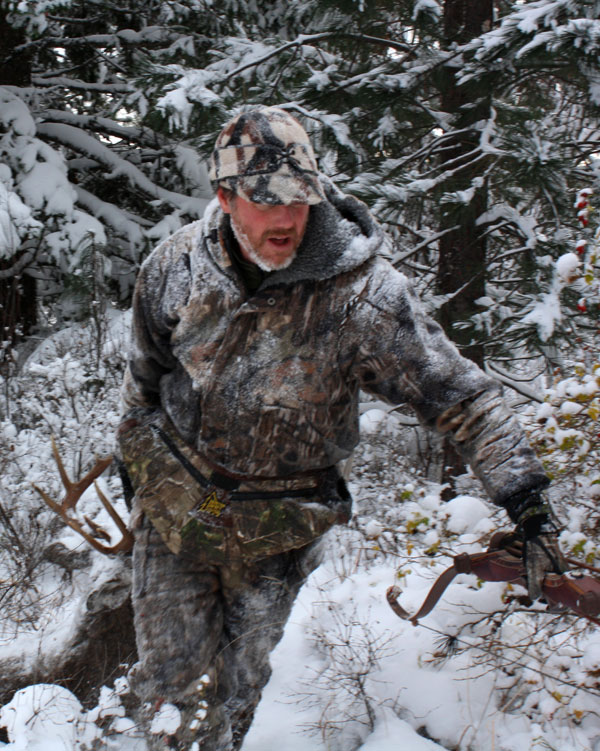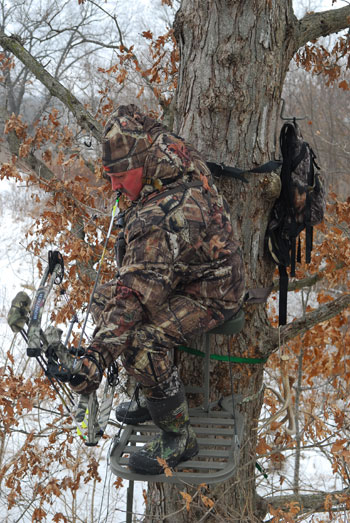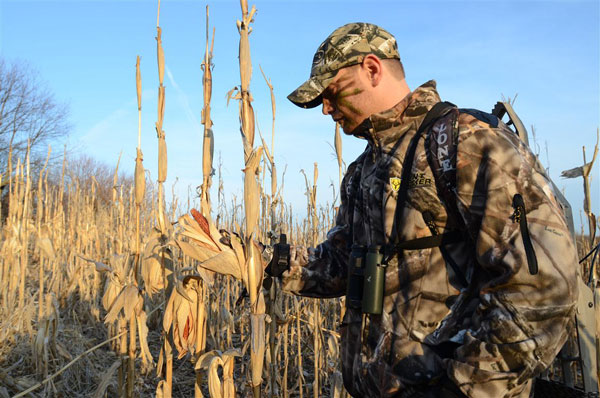LAST UPDATED: May 1st, 2015
For most bowhunters late October through November is where it’s at when thoughts turn to whitetail. These dates coincide with pre-rut (dominance sorting, scrape construction) and direct rutting activities (pursuing does) and make for some of the hottest action of the entire season. Big bucks seldom seen during daylight hours are traveling widely and are more vulnerable than any other time of the season. Of course any bowhunter with a detectable pulse is well aware of these facts.
For other bowhunters early season’s where hopes and dreams are hung – especially “Out West” where seasons kick off as early as August or September, opening the possibility of velvet antlers. Bucks are “soft” from a long summer without hunting seasons, traveling in bachelor groups and generally keeping regular hours bowhunters can form a plan around. Many fine bucks are taken in the first handful of days following archery-only season opener.
Less popular with the average bowhunter are late seasons. I guess this may have something to do with the stigma attached. Finding yourself with a tag still in pocket post rut (whatever that may mean in your hunting area), say late November all the way into January in some locations, is normally a sign things haven’t gone well during sunnier portions of the season. But then, too, late-season bowhunting can also entail taking advantage of bonus tags offered to curtail regional deer herds.
There’s also no way around a couple brutal facts directly related to late seasons: deer have been hunted for several months and are on high alert, and it’s going to be cold – how cold, again, dependent on where you hunt. “Cold” can mean a wet, breezy, 33-degree day in Mississippi or snow and sub-zero temperatures in more northerly regions. By late November in most decent whitetail country a good portion of the best bucks have been eliminated from the equation, survivors well aware there’s a price on their heads. This can make late-season deer as jumpy as a Belfast parking valet. And then, no one really likes to be cold, truly teeth-chattering cold, except maybe Minnesotans or Wisconsin residents.
But this is in no way offered as discouragement against the endeavor. In fact, I’ll generally be the one cheering you on leading into late seasons. As a modern bowhunter you have many positive aspects to encourage further efforts; realistic developments that make late seasons not a desperate effort to salvage your season, but a high-odds proposition with likely reward at the back end.
Late season weather and its killing cold can make you question your sanity at times, but success can happen if your tough enough to carry through. This is a classic case of “No pain, No gain.”
Cold Weather Comfort
To operate efficiently during late seasons you must first operate in super-cold conditions. This, of course, is relative to region. I’ve had bowhunters tell me with conviction that you haven’t experienced cold until you’ve lived through a West Texas winter. I have friends in North Dakota who won’t trade their tennis shoes for cold-weather boots until morning temperatures hit double-digit negatives.
The modern bowhunter has it good. Lightweight bowhunting togs without bulk reserving more warmth are now readily available and relatively affordable. Cold-weather comfort all starts with a smart layering approach, the goal to conserve core body heat to promote maximum transport of warming circulation to outer extremities. Keep the core warm and feet and hands will also stay warmer. Starting the day off right with a hearty breakfast is a good way to start – fuel to stoke the furnace.
While dressing start with quality base layers. Merino wool (naturally antimicrobial), synthetics like Under Armour, or Columbia Sportswear OmniHeat base layers (reflect body heat back to you), aggressively wick moisture that chills after a couple hours on stand, while also conserving maximum heat. Next layer something lofty and well insulated. Depending on temperatures this could be a fleece, wool, down or Primaloft/Thinsulate-filled vest (also allowing unrestricted movement while drawing bows). In colder weather a lofty jacket’s better, like Sitka Gear’s Kelvin duds. In the coldest territories, look to heated garments – from Browning, Gerbing’s or WarmX USA. They’re powered by rechargeable lithium batteries and adjustable for warmth intensity (lower settings increase battery life). Still another option are “sleeping-bag” garments (like the Heater Body Suit, InfernoTek or IWOM) allowing bowhunters to zip themselves inside to retain the most amount of heat possible, the suit silently unzipped and shrugged off when it’s time to shoot.
One of the greatest challenges of bowhunting late seasons is staying warm enough to shoot well without constricting movement. Today’s thinner, lighter, warmer insulations help.
What you choose as an outer layer depends largely on the conditions faced. Drizzling rain or falling snow indicates waterproof/breathable garments; though not just any camo “rain gear” is suited to the intimate ranges involved in bowhunting. Look to quiet fleece or polyester shells that don’t create rustles while shifting or drawing – especially when cold. If windy conditions are your problem, look to togs lined with wind-blocking membranes – again only if they’re bowhunting quiet. Just cutting wind often doubles the effectiveness of an insulating layer. When bowhunting the spookiest whitetail – like Idaho’s mountain lion- and wolf-wary big-woods bucks – I’ve found high-quality wool garments (Sleeping Indian, Columbia Sportswear) are the best combination between weather protection and bowhunting stealth. I can draw on a wound-up buck at 15 yards without alerting him in my Sleeping Indian outfit, and it cuts the wind, sheds light rain and keeps me warm in the coldest temperatures.
Finally, don’t forget head, hands and feet. I’ve tried it all in regards to keeping hands both warm and ready for bowhunting action. I’ve found but one dependable option: waist-mounted hand muff with chemical hand-warmer inserted, and the same thin, stretch-fit camouflage gloves I wear during early seasons to provide maximum dexterity during a fleeting shot opportunity. When it’s cold I wear a Merino wool (First Lite) or fleece balaclava with a waterproof, Sherpa-fleece-lined hat (Whitewater Outdoors) hat pulled over. When it comes to boots, the more insulation the better. I mean, who’s ever heard of getting sweaty feet while sitting in extreme cold. I wear LaCrosse boots sporting 1,200-gram Thinsulate – just as an example – in temperatures ranging from 35 to -15 degrees F.
Follow The Food For Success
After the final doe has been bred, the last scrape checked for the hundredth time without discovering scent, a buck’s mind turns suddenly from sex to refueling the furnace. His very survival may depend on it. At least in harsher portions of the whitetails’ range failing to find enough to eat can result in certain death by starvation. This also results in day-long movement bowhunters need for success. The smart bowhunter quickly abandons the funnel and travel-way mentality that has served him during the rut and turns directly to concentrated food sources.
In some areas this is easy enough, especially in Midwest farm country where harvested corn and soybean fields are still available to hungry deer. In some cases kindly farmers leave a few rows of substandard crop standing here and there to help their deer herds through the toughest days of winter. Depending on region alfalfa, clover or even winter wheat helps feed hungry late-season deer. Given the ground and machinery to create a food plot, turnips make a good late-season setup, as deer will paw the sweet tubers from frozen ground when they get hungry enough. In this respect bowhunting farmland whitetail is always easiest, as food sources are more readily scouted, deciphered and isolated.
Midwest deer hunters have it good in many ways, but especially with respects to late seasons. Food is the key to success and in the better farm ground, even well after harvest food such as corn and soybeans are readily available.
In other areas of the whitetails’ range determining and isolating food-based hotspots requires more knowledge and snooping. Just as an example, in North Idaho where I bowhunt whitetail near home, as the season winds down volunteer apple and pear trees and the leaves provided by patches of blackberry brambles become important food sources. During years when snow doesn’t blanket the landscape volunteer (greens sprouted from waste grain) wheat, barley or oats attract deer like a magnet. On many farms a landowner’s winter alfalfa or hay-stacks become deer central during the coldest weather.
Acorn-bearing oaks are always a good bet for late-season action, especially later-dropping varieties like burr, or second-tier acorns like black and red containing more tannins than sweeter white-oak acorns, but keeping deer alive when there is nothing else in the offing. Scouting out the most productive oak ridges or isolated motts is made easier during late seasons, at least in areas where snow blankets the ground, giving you clear insight into deer traffic and maybe even potential trophy quality.
Then there is baiting — where legal of course. In states where the practice is allowed, like nearby Washington State for instance, there is no better way to spark late-season action than creating a reliable bait site early and leaving it alone until it is needed after the rut has fizzled. There’s no doubt by late season the biggest bucks understand approaching a bait comes with big risks, but plummeting temperatures and a growling belly make the threat of starvation more pressing.
Bowhunting late-season whitetail isn’t for everyone. Sitting in the cold for hours on end and then being forced to perform with cold, stiff muscles is a highly-challenging dodge. But like the old saying goes, when the going gets tough, the tough get going.

 By
By 






